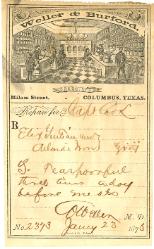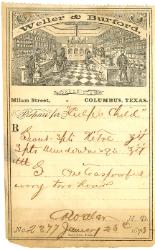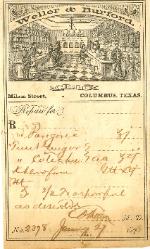Some interesting ingredients (spelling/handwriting on some debatable):
(Daffy's) Elixir Salutis [incl. brandy], Elixir Gentian and Chloride of Iron, Carbonate magnesia and Aromatic spirit of
ammonia and Peppermint water, Quinine sulphate and Elixir tarax(acum) [dandelion] compound, Syrup scillae [squills]
and Syrup ipecac and Spirit nitre and Tinctura opii camphorata [Opium], Quinine (10 grains?) Divided into eight
powders, Sweet spirit nitre and Spirit mindenerus, Paregoric [Camphorated Tincture of Opium] and Tincture of ginger
and Tincture of catechu and Chloroform
"Elixir salutis, the choise drink of health or health-bringing drink being a famous cordial drink, found out by the Almighty,
and (for nigh twenty years) experienced by my self and divers persons." by Daffy, Anthony, London, 1674. English
Reproduction of the original in the Bodleian Library.
FROM WIKIPEDIA:
Daffy's Elixir was one of the most popular and frequently advertised patent medicines in Britain during the 18th century.
It is reputed to have been invented by clergyman Thomas Daffy rector of Redmile, Leicestershire, in 1647. He named it
elixir salutis (lit. elixir of health) and promoted as a generic cure-all. A home recipe for the True Daffy's Elixir, from
William Augustus Henderson Modern domestic cookery book, New York, 1829.
Ingredients: An early recipe for "True Daffy" from 1700 lists the following ingredients: aniseed, brandy, cochineal,
elecampane, fennel seed, jalap, manna, parsley seed, raisin, rhubarb, saffron, senna and spanish liquorice. Chemical
analysis has shown this to be a laxative made mostly from alcohol. Other recipes include Guiuacum wood chips,
caraway, Salt of Tartar, and scammony.
Uses: According to an early nineteenth century advertisement it was used for the following ailments: The Stone in
Babies and Children; Convulsion fits; Consumption and Bad Digestives; Agues; Piles; Surfeits; Fits of the Mother and
Vapours from the Spleen; Green Sickness; Children's Distempers, whether the Worms, Rickets, Stones, Convulsions,
Gripes, King's Evil, Joint Evil or any other disorder proceeding from Wind or Crudities; Gout and Rheumatism; Stone or
Gravel in the Kidnies; Cholic and Griping of the Bowels; the Phthisic (both as cure and preventative provided always that
the patient be moderate in drinking, have a care to prevent taking cold and keep a good diet; Dropsy and Scurvy. The
frequent use of the medicine to treat Colic, gripes or fret in horses was deplored in early veterinary manuals.
Many of the drugs & herbs, have been, over millennia, used recreationally (& nefariously) as much or more than
medicinally!
Some excerpts from:
Consider the Lily:
The Ungilded History of Colorado County, Texas
by Bill Stein
Part 6 1861-1865
small amount of money that had been raised at an 1860 benefit for the Columbus cemetery had been donated to the
company, and, on August 17, the county had donated another $400. The young soldiers stripped to their underwear
and gleefully splashed through the Louisiana swamps. They arrived at New Orleans on September 8 and there boarded
a train. Riding the rest of the way, they reached Richmond, Virginia, on September 17 and waited to go into action.
Before the end of the year, they would receive a number of blankets, socks, and other supplies collected and shipped to
them by Collier's law partner, Richard V. Cook. The blankets were probably carried to the company by David Ellis
Putney, who arrived on October 28 to serve in place of Thaddeus Wright. Wright had recruited Putney as a substitute
so that he could accept a commission as a second lieutenant in the company that Cook planned to raise in Columbus.
A few months after Shropshire's company left town, and even as Upton's Echo Company was enrolling more recruits in
Columbus, Richard V. Cook was raising another company in town. Cook's company, which was formally organized on
March 22, 1862, would be admitted into the Confederate army as Company D of the 21st Texas Volunteer Infantry
Regiment, and would spend most of the war in Texas. The fortunate men in Cook's company would have very different
wartime experiences from those in Upton's or Shropshire's companies. Cook's men would see very little action and suffer
very few casualties. Many would be detailed to other duties around the state; some who were got to spend a
considerable amount of time at their homes. Cook's company sustained one of its few casualties on April 18, 1863.
Stationed near the Sabine Pass, Cook's second lieutenant, Thaddeus Wright, was dispatched with some thirty other
men to capture a handful of United States soldiers who were known to have come ashore the previous evening for
reconnaissance. Thirteen federal soldiers came ashore again the next morning. The waiting Confederates captured
three, but in the course of pursuing the other ten, one of whom would be killed and five of whom would be captured,
Wright was shot through the head and killed.
As fate would have it, Cook's company narrowly missed a chance to play a major role in one of the most celebrated
battles of the war in Texas. A few months after Wright was killed, on September 2, 1863, Cook asked that his company
be sent from the Sabine Pass to Beaumont so that it would not be negatively influenced by what he characterized as
"the recent mutinous demonstrations" by the other parts of the battalion. On September 3, the army agreed to Cook's
request. His company's stay in Beaumont, however, would not last long. On September 8, the United States attacked the
Sabine Pass. The defenders at the pass observed the approach of the Union fleet and sent a message to Beaumont.
Cook, there on duty, received the message, but did not report it to his superior officers until six o'clock the next morning.
The distraught commander, Leon Smith, immediately ordered Cook's company back to the Sabine Pass, where they
arrived too late to do anything but take a number of prisoners from the invading fleet, which had been defeated by
Confederate batteries under the command of Richard W. Dowling.
On December 25, 1861, the state legislature passed a law which again reorganized the state militia, and made, with few
exceptions, "every able bodied free white male inhabitant" between the ages of eighteen and fifty subject to service in
the militia. Generally, militia service consisted of parading around at a company assembly every other week. Those who
missed the assembly could be fined up to $5, though the company captain could waive such fines. Doubtless, his
perceived willingness to do so was a principal factor in his selection, for it was up to the members of each company to
elect the captain. However, Section 34 of the act gave the governor the authority to send the militia into the field. To do
so, he was first required to ask for a sufficient number of volunteers from among the local militia units. If, however, fewer
volunteers than he deemed necessary responded to the call, he was authorized to conscript other members of the units.
The conscription process was quite simple. The local officers were to write the names of the members of their company
on individual slips of paper and draw enough names from a hat to fill the governor's quota. The revised militia system
found its way to Colorado County in March 1862. In that month, twelve companies were organized in the county. The
first captains included Richard V. Cook, Simon Thulemeyer, Thomas L. Townsend, and John Zwiegel, all
headquartered at Columbus, Daniel W. Jackson and John N. Arnold, both headquartered at Oakland, Michael Quin and
Ernst Liermann of Alleyton, and John Hastedt, August Georg, and Frederick Schneider of Frelsburg. In April, Georg,
who had died, was replaced by Bernard Geistmann, and Cook, who had become captain of a company in the
Confederate States Army, was replaced by Cleveland Windrow.
Before the end of the year, Quinn and many of the other men in the new militia companies would follow Cook's example,
leaving the militia commanders to deal with the most unwilling and least able-bodied men in the county. One such militia
commander, the plantation owner Charles William Tait, who was in his late forties, found himself dealing with a near
mutiny. In October 1863, Tait and two militia companies under his command were stationed at the Sabine Pass when
Colonel Augustus Buchel ordered them to a post across the river in Louisiana. Despite Buchel's assurances that they
would return to Texas in only twenty days, Tait's men, grumbling about the rations that both they and their horses
received and convinced that they were of little value to the war effort, refused to leave the state. Efforts to persuade
them succeeded only in dividing the unit into two factions, who bitterly debated each other's respective cowardice and
foolishness. Angered by the incident, Buchel requested that he be sent no more state militia units and Tait offered to
resign his commission. Tait's resignation was refused. Instead, he won a promotion, from major to lieutenant colonel. His
militia companies apparently never left Texas.
| Columbus, Texas Weller & Bufford Druggists C1693 |
| 2373 Capt Cook Gentian & Iron |
| 2372 Capt Cook Elixir Salutis |
| 2377 Culp's Child Nitre & Mindenerus] |
| 2378 Culp's Child Paregoric, Ginger, Catechu & Chloroform |
| WELLER & BURFORD DRUGGISTS MILAM STREET COLUMBUS, TEXAS PRESCRIPTIONS ACCURATELY COMPOUNDED ORIGINALLY FOUNDED IN 1844 as DOCTOR LOGUE'S DRUGSTORE, the FIRST in the REPUBLIC of TEXAS |
| PRESCRIPTIONS: JANUARY 23-27, 1875 The prescription forms are approximately 5 by 3 inches. |
A quite interesting old ledger page,
with . . .
. . . prescriptions that range from two
for an "old" Confederate Captain to
two for an unnamed newborn. "Capt
Cook" certainly refers to Captain
Richard V. Cook (see below), who is
from Columbus and will be movng in
about 2-1/2 years to La Grange,
Texas, the next town up the Colorado
River from Columbus. On the reverse
side are two prescriptions for "Culp's
Child", parents unknown.
with . . .
. . . prescriptions that range from two
for an "old" Confederate Captain to
two for an unnamed newborn. "Capt
Cook" certainly refers to Captain
Richard V. Cook (see below), who is
from Columbus and will be movng in
about 2-1/2 years to La Grange,
Texas, the next town up the Colorado
River from Columbus. On the reverse
side are two prescriptions for "Culp's
Child", parents unknown.
Doctor Logue's Drugstore, known as first
drugstore in Republic of Texas, was founded
in 1844 by Dr. John G. Logue (1815-1861),
who came here after graduation (1842) from
Jefferson Medical College, Philadelphia. A
partner of his for a time was Dr. John H.
Bowers, physician (1836) to captive dictator
Santa Anna. The store has had a succession
of owners. One, Dr. R. H. Harrison, founded
city's railway hospital. Later owners Weller &
Burford served trade area extending to
Gonzales and Bastrop. O. A.
Zumwalt(1870-1951) was proprietor for 48
years. The store operated on various sites
over the years, including 1237 Bowie Street.
drugstore in Republic of Texas, was founded
in 1844 by Dr. John G. Logue (1815-1861),
who came here after graduation (1842) from
Jefferson Medical College, Philadelphia. A
partner of his for a time was Dr. John H.
Bowers, physician (1836) to captive dictator
Santa Anna. The store has had a succession
of owners. One, Dr. R. H. Harrison, founded
city's railway hospital. Later owners Weller &
Burford served trade area extending to
Gonzales and Bastrop. O. A.
Zumwalt(1870-1951) was proprietor for 48
years. The store operated on various sites
over the years, including 1237 Bowie Street.
Richard V Cook, born 27 April 1831
in Tennessee, died 20 August 1877
in LaGrange, Fayette Co., Texas
Captain, Company D, 21st
Regiment, Texas Volunteer
Infantry, Confederate States of
America (or Company A of the
13th?)
in Tennessee, died 20 August 1877
in LaGrange, Fayette Co., Texas
Captain, Company D, 21st
Regiment, Texas Volunteer
Infantry, Confederate States of
America (or Company A of the
13th?)
| 2378 |
| All $45.00 |




